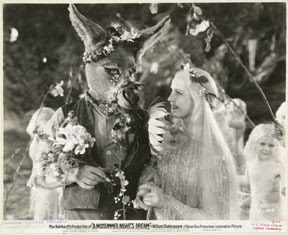Titania and Bottom, with fairies Max Reinhardt production, 1935.
It starred a young Olivia de Havilland, with James Cagney as Bottom the Weaver and Mickey Rooney as Puck. With metal trees painted orange to glow eerily on the black and white film, truckloads of real trees and foliage, 650,000 candles and live owls, doves and ravens, as spangled fairies streamed across the screen, to music by Mendelssohn, audiences and critics were of two minds as to its success.
More stills from the Warner Brothers film,
director Max Reinhardt, designer William Dieterle
The quarrel of Oberon and Titania Sir Joseph Noel Paton, 1849
© Scottish National Gallery
Sir Herbert Beerbohm Tree's famous stage production of 1907, in similar spectacular style, featured real grass and live rabbits, one of which bit Bottom the Weaver when he picked it up.
Scene from A Midsummer Night's Dream, H. Beerbohm Tree, His Majesty's Theatre, London 1900
© Victoria & Albert Museum
Angela Carter's great last novel, Wise Children, is another creative extravaganza, full of Shakespearian allusions, covering most of the plays: "…I wanted it to be very funny, and at the same time I wanted the complex ideas about paternity, and the idea of Shakespeare as a cultural ideology".
She tells the story of illegitimate identical twins, Nora and Dora Chance, the "Lucky Chances", from 49 Bard Road, Brixton, earning a hard living as music hall dancers in the 1930s. "By ourselves, neither of us was nothing much, but put us together, people blinked. Which is Dora? Which is Nora?"
Their story as Dora narrates it intertwines with the famous Hazard theatrical family, their putative father being Melchior Hazard, the great Shakespearian actor-manager of the day. Along with Melchior's twin brother (their 'Uncle' Perry), a succession of wives, and more twin children, the legitimate Hazards, wealthy and successful, seem to be the lucky ones.
The climax of the Chance sisters' career is a trip to Hollywood to play Peaseblossom and Mustardseed in their father's film of A Midsummer Nights' Dream - clearly inspired by Max Reinhardt's famous 1935 film. As pragmatic Dora relates:
"I remember that day, the day The Dream began, as if it were yesterday. We all arrived in costume -- we were a motley crew and no mistake. None of your soppy fairies with butterfly wings and floral wreaths. No, sir. As Peaseblossom and Mustardseed, our bras and knicks had leaves appliquéd at the stress points, there were little lights in our shaggy wigs, and when we saw how the rest had fared in the wardrobe, we thought we'd got off lightly, I must say, because some had antlers sprouting out of their foreheads and fur patches covering up the rude bits; others were done up as flying beetles, in stiff shiny bodices split up at the back; and one or two with boughs, not arms, plus a lavish use of leather and feathers all round.
Furthermore, remember that not fairies alone inhabited the wood near Athens. A giant mouse, saddled and bridled trotted past. A bunny, in a wedding wreath and veil. Some dragonflies, in masks. Several enormous frogs. Dwarfs, giants, children, all mixed up together. Suddenly I had a sinking feeling; I knew it in my bones. This film is going to lose a fortune."
This is a witty, bawdy, irreverent novel, where Carter's imaginative extravaganzas are grounded in the daily realities of the sisters' life: -- from liberty bodices to Grandma's square oilcloth shopping bag or Fuller's walnut cake. It is an irrepressible celebration of its players' humanity.
"We do not come as minding to content you, Our true intent is.
All for your delight, we are not here.
That you should here repent you, The actors are at hand;
and, by their show,
You shall know all that you are like to know."
A Midsummer Night's Dream (the players' Prologue) Act V.











